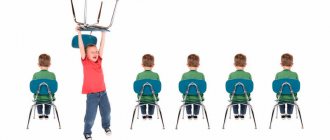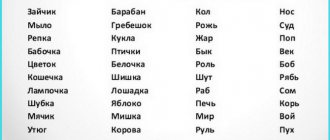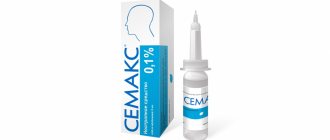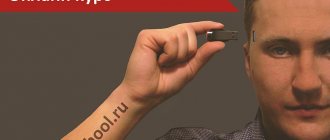Focus in psychology
Our brain, like a computer, constantly analyzes a huge amount of information.
For the most complete picture of everything that is happening around him, he needs to take into account as many details and nuances as possible. In addition to actual objects and phenomena, previously accumulated experience and information are also taken into account. The person himself is not aware of most of this work; it occurs in the subconscious. But we comprehend a significant part. Concentration is the ability to comprehend one thing at a specific moment in time, without allowing information noise to distract consciousness from the main thing. Different people have this ability to varying degrees. Extraneous stimuli, multitasking, and a large number of unsolved problems distract our consciousness from the current action. Read on to learn how to increase your concentration.
What are the properties of attention?
Attention as a mental process includes the following properties:
- sustainability
- switchability
- distractibility
- volume
- concentration
- distribution
Concentration is the most important property for those who constantly use the intellectual sphere in their work. When you are focused on a specific task, you easily see possible solutions, are able to quickly assess the current circumstances and make the right decision.
It’s not for nothing that many executives and managers specifically attend training to improve concentration. The exercises that are demonstrated there help you think clearly, notice any details, and use them to achieve your goals.
The secret of success
All the yogi’s attention and energy should be directed towards completing one task at hand. The slightest leak of attention to the side will instantly reduce work efficiency
This applies not only to yoga practices, but also to the everyday affairs of every person. Therefore, training attention and concentration is doubly useful.
Self-control is one of the main components of yoga. It is common for the average person’s attention to always be in motion, switch and wander. And during important matters, consciousness imperceptibly, but constantly leads thoughts to the side. This phenomenon is normal, but requires work on yourself.
With the achievement of the skill of concentration, a person reaches a completely new level of life. Willpower achieved through concentration directs physical and mental energy in the right direction. This significantly saves energy, allows you to complete assigned tasks faster, and ultimately frees up a lot of free time.
Online trainers for developing attention
There are many services on the Internet for developing brain functions, including attention. I'll introduce you to four of my favorites. All of them are designed according to the same principle - some of the simulators are available for free, but you will have to pay for extended access.
Vikium
Vikium is the most popular training service for brain development today. There you will find exercises and games to develop attention, memory, thinking, and logic. Today there are more than forty of them. The exercises are quite simple, so you can easily fit them into your daily schedule, doing them, for example, during breaks between work.
Bitreynik
On Bitreynik you can focus only on developing attention, or you can train all cognitive functions in a complex. In addition to the exercises themselves, there are many interesting features, for example, tournaments among participants, tests. The tasks are different: some are simple, and some are quite complex.
BrainApps
On the BrainApps service you will find 52 simulators, 18 of which are aimed at training concentration skills. Among them are Schulte tables, tasks for sorting, comparing and searching for shapes. Also on the site you can take various courses, including those on developing attention.
CogniFit
The creators of CogniFit claim that with the help of the service you can not only improve brain performance, develop logic, attention and memory, but also correct some disorders, such as ADHD, insomnia, multiple sclerosis and even the consequences of a stroke. There are programs for both children and adults, as well as a special section for health professionals.
Oxygen, sleep, sugar and drinking regime
Every person should know these 4 factors. The brain needs them for optimal levels of performance.
Oxygen
An open window helps prevent drowsiness while studying. At the same time, it can provide a cooler environment. On the other hand, you may be distracted by some sounds from outside. Therefore, oxygen can be supplied to the body through aerobic exercise during a break. There is no need to train with a heavy load - just do a few squats.
Dream
During sleep, processes of storing information in long-term memory occur. Despite the lack of time, sleep for about 30 minutes to give the brain a chance to change the contents of the memory. Studies have shown that long-term lack of sleep significantly reduces the ability to concentrate. In addition to sleep, relaxation exercise techniques, such as autogenic training and Jacobson's progressive relaxation, help.
Sugar
The brain is a big “consumer” of glucose, so ways to concentrate necessarily include nutrition. This does not mean that you should consume sugar and sweets in large quantities. This diet will quickly increase the amount of sugar in the blood, but in a short time its level will decrease, causing mild hypoglycemia, accompanied by fatigue and hunger. A good choice is a banana or other fruit, oatmeal, rice, but natural honey is best. It is advisable to avoid heavy foods that cause fatigue.
Drinking regime
The liquid accelerates the regeneration of brain cells, ensures the supply of nutrients, and has a positive effect on the chemical processes occurring in the brain during learning. It has been shown that children in elementary and high school who follow a drinking regime have better results in school than schoolchildren who drink little fluid.
How to become attentive?
Many people have noticed that attentiveness is especially heightened at the moment when we are doing other things at work and at the same time watching the boss’s door. This is one of the simple and effective exercises for training concentration. But there are other simple techniques aimed at improving attentiveness and parallel actions, developing the ability to switch to other processes. By doing them regularly, you will see noticeable results over time.
Surrounding reality
It’s good to practice mindfulness on the way to work or while walking. Instead of immersing yourself in your own thoughts, it is better to pay attention to the people around you, noticing as many different details as possible.
For example, meeting a neighbor. Having said hello as usual, it is worth noting to yourself his name, appearance, a bright or remarkable detail of his clothing. Mentally make up a couple of phrases: “Volodya – a leather jacket, like a colleague’s” or “Larissa – green wedge shoes.” Such entertaining associations will help you quickly remember the name and image of a person.
And while in transport, you need to try to remember advertising signs, outlines of objects, landmarks on the road, terrain features, in a word, anything that will force you to pay attention to the little things. And on the way back you should remember everything that was discussed in the morning.
This method of concentration further develops observation skills. In the future, you will unconsciously begin to catch the nuances that catch your eye and remember more information.
Special entertaining techniques
Mindfulness can be trained in a fun and interesting way. This type of training includes solving puzzles, crosswords and rebuses, assembling puzzles, any board games, and various attentiveness tests. Activities that require concentration improve the ability to concentrate significantly.
The simplest game is “Find the Differences”. Through vision, 90% of information is absorbed, therefore, through visual perception, concentration, observation and memory are gradually trained. In the future, a person will learn to quickly assess the situation and make a worthy decision.
Other options for training mindfulness using pictures:
- games related to searching for more homogeneous objects in a picture;
- images that allow you to view a picture using 3D technology from a certain angle;
- drawn labyrinths through which you need to find your way to an object or exit;
- searching for numbers or objects in encrypted geometric shapes, etc.
You can also practice mindfulness in the company of friends, for example, by playing the game “What Has Changed.” It asks one participant to leave the room while the others exchange accessories or items of clothing. Then the player who returns to the room is asked to determine who is wearing other people’s things. Another option is to take the whole company to an quest room, where you will have to demonstrate your intellectual abilities, attention, and speed of reaction.
We don't switch
Psychologists note that concentration of attention during the work process is constantly scattered. This especially happens against the backdrop of accompanying events: the aroma of coffee, after which you want to get up and make a cup of coffee, or a bouquet that attracts you with a wonderful smell, or a group of colleagues discussing going to the movies. We get distracted, but through an effort of will we return to current affairs and notice that we cannot get back on track and make mistakes.
It is possible to control such switching moments. First, let's do a simple exercise . To perform it, you need to turn on the TV and find an exciting program. For two minutes you should look at the clock with the second hand and not be distracted by the TV screen. After the time has passed, retell what was discussed in the program. If you can’t remember anything, it means that at this stage to develop attentiveness.
Another method involves control in writing of all switching moments. Throughout the day we keep notes in a notebook, and before leaving home we count them. At the same time, as soon as you need to make a recording, we mentally ask ourselves the question: “Do I really want to do this or think about it?” Such actions allow you to control moments of distraction. As a result, the total time spent on extraneous actions or thoughts can range from several minutes to hours. For many, this method will make them value their own time more and not waste it on trifles.
Scientists have proven that the more you practice strengthening concentration and focus, the more they take root at the subconscious level. Be attentive to the little things , try to keep two or even three actions under control, do not be distracted from the main thoughts, play useful games. An integrated approach will help you achieve the desired results much faster.
Medicines to improve attention in children and adolescents
Children and adolescents require increased concentration during the learning process, and therefore are more susceptible to mental overload. Nootropic drugs improve blood circulation and metabolism in brain cells, activate thought processes and promote good study.
Modern medicine offers a large number of means to stimulate the nervous system of schoolchildren. Medicines to improve brain activity are available without a prescription, but they must be taken strictly as prescribed by a neurologist or psychiatrist. Their uncontrolled use, especially in children, can be dangerous.
Basic drugs to improve memory and attention:
- Glycine is a nootropic drug that increases performance, normalizes sleep, has a sedative effect, improves mental abilities, and activates protective inhibition processes in the central nervous system. Release form: tablets that dissolve under the tongue until completely dissolved.
- Piracetam - has a positive effect on metabolic processes in the brain, promotes better assimilation of educational material. But if there is a history of individual intolerance or renal failure, the drug is contraindicated. Release form: tablets and capsules.
- Biotredin. The drug contains vitamin B6 and threonine - substances that have a positive effect on the nervous system. The product activates the cognitive functions of the brain, has a calming effect, and helps improve memory and attention in adolescents. Release form: tablets.
- Phenibut is a nootropic drug that stimulates blood flow to the brain, reducing the tone of its blood vessels. When using this medicine as prescribed by a doctor, mental performance significantly improves, memory and the ability to remember large amounts of information are activated. The product is available in tablet form.
- Aminalon is a gamma-aminobutyric acid preparation. Restores metabolism in the brain, improves glucose processing, and removes toxins. Indicated for disorders of the nervous system, to activate mental activity. Release date: tablets.
- Pantogam is a nootropic drug containing gamma-aminobutyric acid as an active ingredient. Indicated for psycho-emotional overload, attention and memory disorders, to activate intellectual activity, and relieve nervous tension. Release form: syrup, tablets and capsules.
- Tenoten is a homeopathic medicine that improves the nutrition of children's brain cells, accelerates the maturation of the child's nervous system, and promotes the activation of brain processes. Available in tablet form.
- Noben is a product based on coenzyme Q10. As a result of intake, the concentration of this substance in brain cells increases, memory and the processes of remembering information are activated. Release form: capsules.
- Bilobil (analogs - Tanakan, Biloba and others) is a medicine based on an extract of the ginkgo biloba plant. Normalizes the tone of small vessels in the brain, stimulates the nervous system, and has a slight calming effect. The product is available in tablet form.
- Intellan - relieves nervous tension, effective for mental overload. Release form: syrup and tablets.
- Phezam is indicated for disorders of mental function, decreased memory and concentration, as well as retardation in intellectual development. The product eliminates irritability and promotes better learning. Release form: capsules.
From the editor: Treatment and symptoms of mixed type dystonia
It must be remembered that drug treatment for brain disorders alone will not be enough. You can develop intellectual functions by any available means - memorization, reading, various educational games. In addition, the child needs the care and support of his parents. Only if all these conditions are met can excellent results be achieved in a fairly short period of time.
Vitamins for brain activity
Vitamins, especially group B, contribute to the development of memory, attentiveness and thinking in adults. These substances are antioxidants and can support the functioning of the central nervous system.
Vitamins to improve memory:
- B1 - responsible for the ability to quickly assimilate new material;
- B2 - capable of accelerating mental processes;
- B3 - affects the speed of memory, concentration. Necessary for those who are concerned about how to develop mindfulness;
- B5 - responsible for long-term memories;
- B6 - accelerates thought processes and increases intelligence;
- B9 - is responsible for the stability of memorization, increases performance;
- B12 - helps recode information from short-term memory to long-term memory, during sleep.
A lack of B vitamins inhibits the synthesis of amino acids, which leads to memory impairment. In addition to group B, there are other vitamins that can stimulate brain function:
- Vitamin C promotes better absorption of B-group nutrients and prevents mental overload.
- Vitamin D – protects brain cells from premature aging.
- Vitamin E – resists the harmful effects of toxins, helps to perceive new information more easily.
- Vitamin P – improves concentration and attention.
It is worth taking a blood test to determine the composition of hormones and microelements in the body. If any substances are missing, the doctor will tell you how to replenish them.
Important! Vitamins that stimulate brain activity should be used in combination.
Training memory and attention in adults - the best exercises
Classes to improve memory in adults are not such a difficult task. If you wish, you don’t have to waste extra time on training attention in adults. Listen carefully to your friend, trying to remember the color of his shirt, shoes, coat, eyes, hair. After you part, try to remember these colors.
While walking down the street, try to remember the numbers of buses or cars passing by. If you are stuck in a traffic jam or have a long ride on a trolleybus, solve crosswords and scanwords
They are great for training memory and attention.
Memorize three words of a foreign language every day. Learn poetry, read at least 20 pages a day. These simple ways train the brain and memory of busy adults.
Try not to overwork and eat right. Fresh fruits and vegetables, greens, a lean diet, enough calories, a varied menu are necessary to nourish brain cells.
Properly organized daily routine
The key to a child’s successful education is a properly organized daily routine. It will be easier for a child to “join” the school process if he has a clear work and rest schedule. One of the most important aspects is sleep. A primary school student should sleep about ten hours at night. There can be no talk of concentration or productivity if the child comes to class sleepy.
Extracurricular activities are good, but in moderation. When parents immediately after school take their child from one elective to another, there will be no benefit. The child is not able to cope with such a volume of information and will simply get tired. The baby should have free time when he can relax.
From the editor: Causes, symptoms and treatment of Wilson-Konovalov disease
Also, for the healthy development of a child, you need to arrange walks in the fresh air every day, lasting two to three hours. By the way, walks can also include active games, for example, with a ball
In general, sports activities are very effective in increasing attention and concentration. Therefore, the baby can be sent to dancing or to a sports section
It is very important to organize your child’s workspace at home. This can be a separate room or your own corner in the apartment
Here the student will complete his assignments and also store all his textbooks and notebooks. It is also important to teach your child to keep the workplace in order. It is advisable for the child to do homework at the same time every day. In the future, this principle will help the child to quickly engage in the process of studying school subjects.
While doing homework, the child should not be distracted by anything. It is better to turn off the TV; family members should not talk loudly. The absence of external stimuli will help the baby concentrate better and quickly complete homework.
Factors influencing memory development
Memorization efficiency is affected by age and health status. Over time, memory deteriorates. After 30 years, you need to make more efforts to maintain memory functions and intelligence in old age.
Elderly woman reading
Important! Stress, overwork, and anxiety negatively affect the emotional state and affect the ability to quickly remember information. Some medications, alcohol, and caffeine in uncontrolled quantities impair memory
Information is better absorbed if:
- It arouses interest, the process of learning is easy, with pleasure;
- Associated with bright positive emotions and impressions;
- Used in practice;
- Understandable, presented in easily accessible language;
- Often meets.
The information provided must be logically structured; this is what will allow it to be analyzed and captured for a long time. A person can resort to rote memorization when data remains in memory in the form in which it was presented and is memorized. Such information will not remain at a person’s disposal for long. You need to think about what you hear, be able to highlight the main idea, trace the connection and logic. Then the main points that convey the essence of the story will be stored in memory.
Useful exercises for training
Experts say that attention can be considered developed if a person adheres to the following rules in his activities:
Can create the necessary motivation by recognizing the importance of work. Exercise control over the arbitrariness of mental processes. Removing distractions that interfere with attentiveness It is well known that the beginning is half the battle, so you need to be able to eliminate distractions. Learn effective techniques for developing attention, since the psyche is structured in such a way that continuous development is necessary to maintain it in good shape. The main rule is that you can’t be half attentive; then an activity will bring success when all your attention is focused on it. attention and thinking. For your information
To follow these rules, attention training is necessary, it is better if it is a complex technique, where useful exercises involve the combined development of memory, attention and thinking
For your information. To follow these rules, attention training is necessary, it is better if it is a complex technique, where useful exercises involve the combined development of memory, attention and thinking.
Regular healthy training helps improve attention
For adults
Psychologists suggest that adults first master basic exercises and then complicate and diversify them.
Anyone can choose the most suitable attention exercises for themselves. The main thing is that they are accessible and do not require unnecessary preparation:
From the editor: Ways to develop fantasy and imagination
- “Labyrinths” - a simple way of training can be easily found in magazines or on websites. You can practice visually finding a way out of tangled lines everywhere: in transport, during a break at work.
- A similar exercise, “Corrective Test,” is offered on many online sites. You need to use your eyes to identify words among a chaotic set of letters.
- “Find the mistake” is an interesting task for adults and children. In two identical pictures you need to find differences that are invisible at first glance. You can only detect them if you look closely at the images.
For children and teenagers
For your information. Children of preschool and primary school age may find monotonous training boring. Therefore, it is better to make all tasks interesting and exciting.
Exercises with mathematical content are useful
You can consolidate your knowledge in mathematics and develop your attention. The kids will love the math lotto, which requires large cards with examples and small cards with answers.
The presenter shows the answer card, the players must close the corresponding example on the large card. Classic simulators are graphic dictations that are suitable for preschool and school-age children. Their essence is to draw various patterns or pictures in a squared notebook under dictation. The older the preschooler, the more difficult the tasks. Children love funny games and exercises to develop attention. Therefore, they are more willing to respond to tasks with humor: “Nonsense”, “What did the artist mix up”, “Which word is superfluous”, “Say the opposite”. You can offer logical exercises for attention for teenagers: puzzles, logical problems. A tangram-type simulator is considered popular. A large square is cut into different elements. Then a picture is assembled from the parts.
Tangram for children is a great attention training
- The “Digital Poems” exercise will appeal to both preschoolers and primary schoolchildren. The idea is to pronounce numbers in a certain rhythm, starting slowly and then speeding up, for example, a counting rhyme:
- 2, 12, 46;
- 48, 3, 06;
- 33, 1, 102;
- 8, 10, 32!
You can encrypt any numbers using this method.
This exercise helps develop not only attention, but also logic and memory.
Ways to concentrate that work
There are many exercises that help you keep a topic in your head and completely immerse yourself in it.
If a person is not distracted by other actions and thoughts, devoting all his attention to one issue, he will solve it faster and the decision will be chosen correctly. The human brain is like a muscle that needs to be exercised. Let's consider several effective psychological techniques and exercises for concentration.
Free observation
This technique of concentration will teach you to free yourself from constant analysis and the second stream of thoughts:
- Sit in a comfortable position, become an observer.
- Don't think, don't analyze what's happening to you at the moment.
- Your job is to feel.
- Let thoughts come and go, observe without dwelling on them.
This concentration exercise should be performed every day, for 5-10 minutes. You can do this on the street, at work or at home. Try to look at the space around you without the prism of your emotions and memories. It’s as if you are seeing everything for the first time. You will be able to get new impressions from old, familiar things by adjusting your concentration and managing your associations.
Exercise "line"
A good exercise for concentration in adults. You will need a pen and paper. The point is that a person begins to draw a line by hand. The hand should lie on the table in a comfortable position. As soon as the pen touches the paper, all thoughts should turn off. At this moment, you no longer analyze or think about anything. You draw a line. The remaining processes do not exist.
If you notice that you are distracted by something, draw a peak, like on a cardiogram line. After this, the exercise continues. Completion time: 3-4 minutes. The line can be continued below if the sheet runs out. But try to draw it so slowly that there is enough space for all three minutes. This is one of the most effective exercises.
A result in which there will not be a single peak on the sheet can be considered a success.
Exercise "colorblind"
The exercise is aimed at focusing attention on specific aspects of the case. Below are the names of the colors. All of them are highlighted in different colors. It is necessary to pronounce out loud not the word, but the color with which it is designated. For example, if the word “blue” is written in yellow, you need to say out loud: “Yellow.”
This is not easy to do, since the human brain is accustomed to reproducing what is written exactly. The exercise serves as a training for concentration.
Exercise "fly"
A more complex psychotechnical technique. Maximum concentration of attention will help to execute it exactly. The exercise is quite complex and is often used in group therapy.
- Sit comfortably and close your eyes.
- Draw an imaginary board in your head with 9 cells, arranged 3 in a row. Just like in the game “tic-tac-toe”, only the edges of all the cells are closed. Now place an imaginary fly in the center.
- Move it from cell to cell in any order so that it does not go out of bounds.
- If you are distracted and the fly is over the line, the game stops, the fly is returned to the central cage and starts over.
In group therapy, when performing this technique to concentrate attention, the psychologist gives the command. If you are doing the exercise on your own, move the fly randomly, but within these nine squares.
Calm body position
There is nothing simpler, it would seem, to sit down and relax. But this is only in theory. In fact, a person is so multifunctional that it is quite difficult for him to stop doing a million things at once. The exercise is performed in 3 stages:
- Relax, take a comfortable position.
- Your task is to sit in a chair for 5 minutes without thoughts or body movements.
- Not a single muscle should tense. If this happens, relax her and continue.
The essence of the method is to teach the brain to turn off “background processes” and concentrate entirely on one task.
This exercise will show how many muscle tensions a person’s thoughts and feelings create. When remembering an embarrassment or an unpleasant situation at work, some muscles automatically tense. And when a person has a lot of worries, he turns into a complete bundle of nerves. Clamps prevent normal blood flow. As a result, body diseases develop.
The ability to relax is the key to health and the basis of meditative practices. Do the exercise every day. You will not only improve your concentration, but also improve your health.
Concentration on fingers
A simple but very effective exercise for concentration. Demonstrates how much control you have over your body.
- Extend your arm forward, palm facing the floor.
- Look at your fingertips, slowly begin to move your head in the opposite direction.
- The task is not to lose sight of the fingers, leaving the hand motionless. She should not “follow” her head.
- If you extend your right arm forward, your head turns to the left. And vice versa.
Achieve a perfectly even, stationary position for your hand. Learn not to lose sight of your fingers.
Exercises for concentration with water
An exercise demonstrating the ability to “merge” with an object. Relaxes. An effective exercise for concentration.
- Fill a transparent glass with water halfway.
- Stand straight with this glass, distributing your body weight on both legs.
- The goal is to keep the water still.
You must learn to breathe in such a way that it does not create vibrations in the glass. Start with one minute and gradually increase the time.
How to improve concentration with a fist
Effective finger concentration training:
- You need to take a comfortable position at the table.
- Place your hands on its surface, palms down.
- We clench our hands into fists.
- Now, starting with the little finger of the left hand, straighten the fingers one by one.
- Next is the right hand, starting with the thumb.
- We squeeze in the reverse order: from the little finger of the right hand, the thumb of the left.
Repeat 5 times. During the gradual clenching and straightening of the fists, all attention should be focused on the movements.
Focusing on smells
A technique important for the overall development of a person. Useful training for attention and concentration.
- Take a scented candle, fresh flowers or your favorite eau de toilette.
- Focus all your attention on the smell. Turn off thoughts, other feelings, emotions.
- Try to feel the full palette of aroma.
Another concentration exercise:
- Sit in a chair, close your eyes.
- Focus your attention on the tip of your nose.
- Now imagine that the tip of your nose is stained with lemon. It was like cutting a lemon in half and running it along the tip of your nose.
- You will feel increased salivation.
- Sniff, smell the lemon.
- Try to taste it as if you had licked a lemon.
At the end of the exercise, an indicator of a good result will be the feeling that your nose is still stained with lemon and needs to be wiped off.
Listen to your body
Turn off monitoring of external processes, focus on internal ones. Imagine blood circulating throughout your body, giving you warmth. Think about how air moves in and out of your lungs. Spend 3-5 minutes a day on this exercise. This is not only a way to train concentration, but also a relaxing meditative procedure.
Reflection exercises
Method used in acting practice:
- Stand in front of a mirror and draw two marks on it in the eye area.
- Imagine these are the eyes of another person.
- Look at him calmly, try to seem like a confident person.
- Don't look away, don't blink too often.
- Your breathing should return to normal.
By learning to look boldly into the eyes of other people while controlling your facial expressions, you will acquire a useful skill of concentrating and become a confident person.
Eastern version
Another great exercise showing how to learn to concentrate. It is performed while sitting in a chair. You need to pinch the right side of your nose with your finger, inhale with your left, exhale very slowly, counting to ten.
As you exhale, you will be focused on keeping up with the count. The exercise is repeated with both nostrils 3-5 times. If you start to feel dizzy, stop the exercise. Return to him in half an hour. The method helps to put feelings in order and get rid of negative emotions. This is also an effective exercise for concentration.
Imagination game
This exercise can be practiced on a minibus, in a crowded place, at work or at home. It is important that you can sit and have an object in front of you to observe.
Let's say you are at home, you have a cat. Mentally imagine her wearing a hat. While the cat performs the actions: walks, licks its fur, hold an imaginary hat over its head. 1-3 minutes of practice is enough. It is important not to get distracted or lose sight of the hat.
At work, this will help not only to concentrate, but also to relax. You can imagine that your boss has grown a trunk or that your colleague is walking around the office in an elf costume. Everything that your fantasy and imagination can handle. Don't lose sight of the point: it's important not to have fun, but to concentrate and not lose sight of the subject. Also, do not abuse this by confusing people. Try to train without others noticing.










